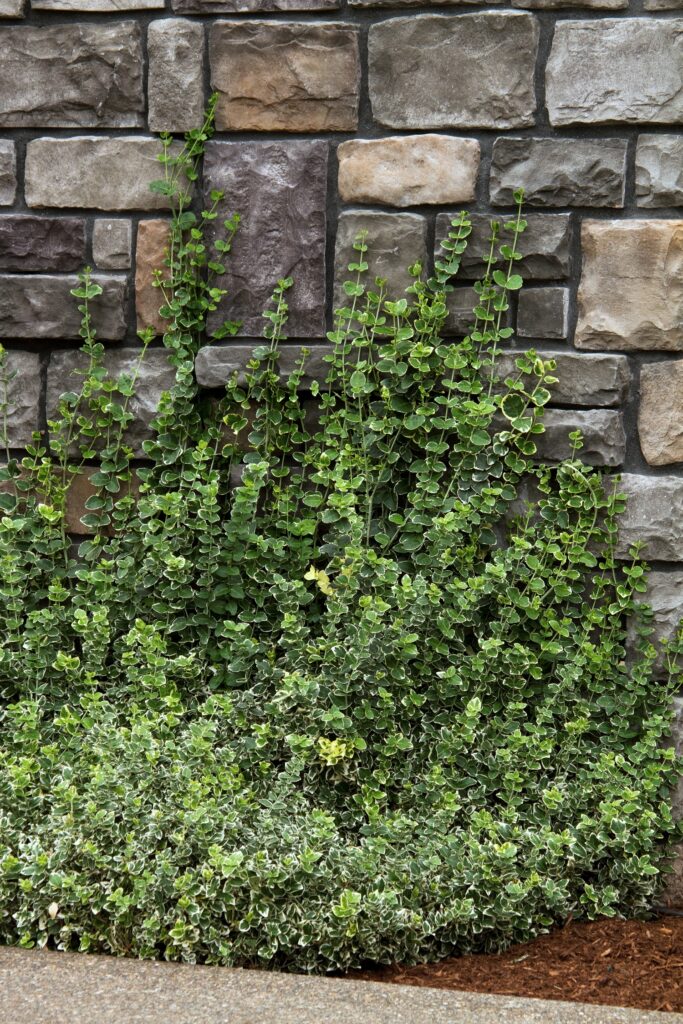By Ken Lain, the mountain gardener

A very brilliant plant that makes dreary winter landscapes more cheerful. Creates a single fine specimen. Its low stature makes a fine barrier hedge inside existing gardens or along the perimeter. This hardy shrub is excellent for hot climates with definite winters. The fine texture and size of the plant make for good hedges or screens. May grow into a natural orb or can be sheared into a formal hedge or simple topiary forms. Take advantage of its unique minty character.
Wintercreeper’s scientific name, forutnei, comes from plant explorer Robert Fortune. Its common name derives from its habit of creeping steadily higher and higher as it grows. Wintercreeper can climb up to 40 feet as a juvenile plant if it has support. However, it generally stops creeping once it reaches full maturity. It will spread out as ground cover, or it can be kept trimmed as a shrub about 2 feet tall.
Botanical Name Euonymus fortunei
Common Names Wintercreeper euonymus, Wintercreeper
Plant Type Evergreen shrub
Mature Size Up to 40 feet as a vine; usually kept to 2 to 4 feet as a mounding shrub.
Sun Exposure Full sun to part shade
Soil Type Medium moisture, well-drained soil
Soil pH 6.0 to 8.0
Bloom Time April
Flower Color Greenish white (flowers are insignificant)
Hardiness Zones 5 to 9 (USDA)
Native Area Asia
PLANTING A WINTERCREEPER EUONYMUS
Choosing a site for this tree should allow for its mature height the plant. The canopy tends to grow in a narrow upright shape. Never plant shrubs deeper than planted initially in the pot. Doing so can cause rotting of the stem and death to the tree.
1. Dig a hole 2-3 times the width of the container but the same depth.
2. Check drainage by filling the hole with water. All water should drain away within 12 hours. If not, you have hardpan, and it will need to be penetrated – dig deeper & add a layer of gypsum.
3. Watters “Mulch” – Blend 1 part mulch with two parts soil taken from hole.
4. Score the root ball sides and bottom with a utility knife or pruners.
5. Blend Soil – Mulch – 7-4-4 Plant Food & Aqua Boost mixture, then pack firmly around the rootball.
7. Build a well around the tree and water with “Root & Grow” mixture.
Water with Root & Grow every 2 weeks for the first 2 months.
Light
Wintercreeper thrives in full sun to part shade, but it can tolerate a significant amount of shade.
Soil
Wintercreeper proliferates in average, medium moisture, well-drained soil. It prefers alkaline soil but will tolerate many different soil conditions, including compacted soil, various pH levels, and dry (drought) soil conditions. But it does not do well in wet ground.
Water newly planted trees regularly with a garden hose for at least one month (2 months in Summer). Automatic irrigation systems may not be sufficient initially. Water frequency will vary according to the season, exposure, and plant size.
April – Oct this Pine should be irrigated 2 x weekly.
Nov – Mar this Pine should be irrigated 2 x monthly.
Feed 4x Times per Year with either 7-4-4 All Purpose Plant Food, Soil Sulfur, or Humic. Here’s the recommendation by season:
Spring = 7-4-4 All Purpose Food + Soil Sulfur
Summer = 7-4-4 All Purpose Food + Humic
September = 7-4-4 All Purpose Food
December = 7-4-4 All Purpose Food
TEMPERATURE, HUMIDITY, AND ZONE
Wintercreeper euonymus does well in all climate conditions found in USDA hardiness zones 5 to 9. In areas with harsh winters, Wintercreeper can suffer some winter damage from ice and dramatic temperature fluctuations. Fortunately, this resilient plant is very good at recovering from the effects of winter.
PRUNING
Pruning can be done either to control the plant’s spread or keep it in the desired shape—such as to keep it in a mounded shape rather than spread as a ground cover. Major pruning should be done after the summer flowering is complete.
PROPAGATING
Wintercreeper is easily propagated from new-growth cuttings. With sterilized cutting shears, take a 4 to 6 inch length of stem with at least 4 pairs of leaves. Strip off a bottom couple of leaves and place the cutting in moistened Watters Potting Soil. Keep the potting soil moist until roots at least 1 inch long have emerged from the nodes where the leaves were removed, then transplant into a larger pot. Make sure to harden the plant off before transplanting into the garden.
VARIETIES OF WINTERCREEPER EUONYMUS
- ‘Emerald Gaiety’ has green and white leaves.
- ‘Emerald ‘n’ Gold’ has green leaves with wide yellow margins. It can mound into a shrub 4 to 5 feet in height.
- ‘Emerald Surprise‘ has green foliage with smaller yellow margins.
- ‘Canadale Gold’ has glossy leaves with golden margins. It is a mounding form but is also suitable for vine training.
- ‘Minimus‘ is a small mounding cultivar, growing to only about 18 inches but with a 6-foot spread. Known as “baby wintercreeper,” it has relatively small leaves.
- ‘Coloratus‘ is known as purple-leaved Wintercreeper. It is a low spreading cultivar with leaves that have purplish color on the undersides.
Toxicity
Euonymum fortunei is considered a toxic plant but is it poisonous only if consumed in large quantities, so there’s no need to be too concerned.
Common Pests/Diseases
One of the most common problems you may face with many types of Euonymus shrub is the Euonymus scale. This armored insect attacks the leaves and stems of infected plants. Treat for scale by pruning off infected branches and/or applying a horticultural oil at the appropriate times of the growing season. This is late May to early June and late July to early August, during the insect’s two hatches.

